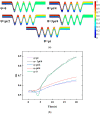Numerical Analysis of Mixing Performance in an Electroosmotic Micromixer with Cosine Channel Walls
- PMID: 36363954
- PMCID: PMC9695434
- DOI: 10.3390/mi13111933
Numerical Analysis of Mixing Performance in an Electroosmotic Micromixer with Cosine Channel Walls
Abstract
Micromixers have significant potential in the field of chemical synthesis and biological pharmaceuticals, etc. In this study, the design and numerical simulations of a passive micromixer and a novel active electroosmotic micromixer by assembling electrode pairs were both presented with a cosine channel wall. The finite element method (FEM) coupled with Multiphysics modeling was used. To propose an efficient micromixer structure, firstly, different geometrical parameters such as amplitude-to-wavelength ratio (a/c) and mixing units (N) in the steady state without an electric field were investigated. This paper aims to seek a high-quality mixing solution. Therefore, based on the optimization of the above parameters of the passive micromixer, a new type of electroosmotic micromixer with an AC electric field was proposed. The results show that the vortices generated by electroosmosis can effectively induce fluid mixing. The effects of key parameters such as the Reynolds number, the number of electrode pairs, phase shift, voltage, and electrode frequency on the mixing performance were specifically discussed through numerical analysis. The mixing efficiency of the electroosmotic micromixer is quantitatively analyzed, which can be achieved at 96%. The proposed micromixer has a simple structure that can obtain a fast response and high mixing index.
Keywords: electroosmotic; micromixer; mixing performance; numerical simulation.
Conflict of interest statement
The authors declare no conflict of interest.
Figures















References
-
- Chen X., Li T., Li X. Numerical research on shape optimization of microchannels of passive micromixers. IEEE Sens. J. 2016;16:6527–6532. doi: 10.1109/JSEN.2016.2586583. - DOI
-
- SadAbadi H., Packirisamy M., Wuthrich R. High performance cascaded PDMS micromixer based on split-and-recombination flows for lab-on-a-chip applications. RSC Adv. 2013;2013:7296–7305. doi: 10.1039/c3ra40910d. - DOI
-
- Chang S., Cho Y.H. Static micromixers using alternating whirls and lamination. J. Micromech. Microeng. 2005;15:1397. doi: 10.1088/0960-1317/15/8/004. - DOI
-
- Dertinger S.K., Chiu D.T., Jeon N.L., Whitesides G.M. Generation of gradients having complex shapes using microfluidic networks. Anal. Chem. 2001;73:1240–1246. doi: 10.1021/ac001132d. - DOI
Grants and funding
LinkOut - more resources
Full Text Sources

